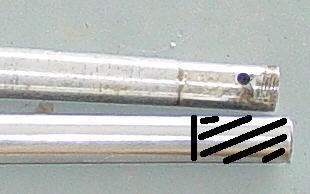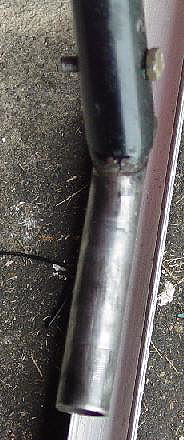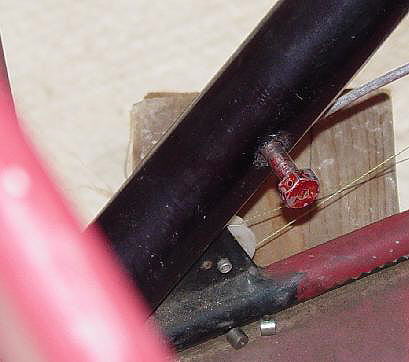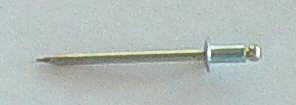|
|
 The replacement leg was 1.5 inches longer than the original leg so the excess material was cut away from the upper end.
The replacement leg was 1.5 inches longer than the original leg so the excess material was cut away from the upper end.
|
 The lower end OD was .010 inches larger than the original leg. A felt tip marker was used to stripe (simulated in the photo) the lower OD. Then the leg was mounted in a vice, and a flat file was used to remove material around the OD. By holding the file at an angle and rocking over the surface and rotating the leg in the vice one can get a very consistent removal of material. Only take off material until the striping is removed. Start with favoring the lower end. After removing all striping, try to slide the axle assembly socket onto the leg. If it will not start, re-stripe the leg and repeat the process. Once the socket will start to slide onto the leg, one can rotate the axle assembly on the leg and it will leave a shinny mark on the leg surface. Using a small flat file, remove the shinny surface(s) and repeat the process until the socket slides onto the leg.
The lower end OD was .010 inches larger than the original leg. A felt tip marker was used to stripe (simulated in the photo) the lower OD. Then the leg was mounted in a vice, and a flat file was used to remove material around the OD. By holding the file at an angle and rocking over the surface and rotating the leg in the vice one can get a very consistent removal of material. Only take off material until the striping is removed. Start with favoring the lower end. After removing all striping, try to slide the axle assembly socket onto the leg. If it will not start, re-stripe the leg and repeat the process. Once the socket will start to slide onto the leg, one can rotate the axle assembly on the leg and it will leave a shinny mark on the leg surface. Using a small flat file, remove the shinny surface(s) and repeat the process until the socket slides onto the leg.
Slide the axle assembly onto the leg, center punch the leg through the bolthole and drill the .250 hole. |
 The most difficult part of the replacement was how to locate the upper leg hole. The distance from the top of the steel axle assembly to the bottom of the cage socket was measured on the "good" side. This position was marked on the new leg. The leg was inserted into the socket and up to the mark. The jack was lowered until the axle was at the same height above the floor as on the good side. Then a straight piece of scrap aluminum channel was slipped under the jack. The forward channel edge was located from the vertically below the head of the axle assembly bolt on each leg.
The most difficult part of the replacement was how to locate the upper leg hole. The distance from the top of the steel axle assembly to the bottom of the cage socket was measured on the "good" side. This position was marked on the new leg. The leg was inserted into the socket and up to the mark. The jack was lowered until the axle was at the same height above the floor as on the good side. Then a straight piece of scrap aluminum channel was slipped under the jack. The forward channel edge was located from the vertically below the head of the axle assembly bolt on each leg.
|
 Rotate the leg in the socket until the axle is true with the channel. Then check everything over to be sure nothing has moved and scribe the leg surface through the front socket bolthole inside the cage. Remove the leg from the socket. Carefully center punch the scribed circle, and using a Vee block and/or vice to hold the axle, drill the .250 hole.
Rotate the leg in the socket until the axle is true with the channel. Then check everything over to be sure nothing has moved and scribe the leg surface through the front socket bolthole inside the cage. Remove the leg from the socket. Carefully center punch the scribed circle, and using a Vee block and/or vice to hold the axle, drill the .250 hole.
If you do not have a scriber, sharpen a stainless steel pop rivet mandrel end. It will work very well.
|
 Slide the gear leg into place and try to slide a bolt through the hole. If the hole does not perfectly match, mine did not, I had to use a hand drill through the front cage hole and gear leg to clear out the hole on the backside. Once this was done, alignment was checked for toe-in and it looked good. If this were not the case, the camber adjustment tool used in the previous page would have been used to correct the toe-in.
Slide the gear leg into place and try to slide a bolt through the hole. If the hole does not perfectly match, mine did not, I had to use a hand drill through the front cage hole and gear leg to clear out the hole on the backside. Once this was done, alignment was checked for toe-in and it looked good. If this were not the case, the camber adjustment tool used in the previous page would have been used to correct the toe-in.
|
